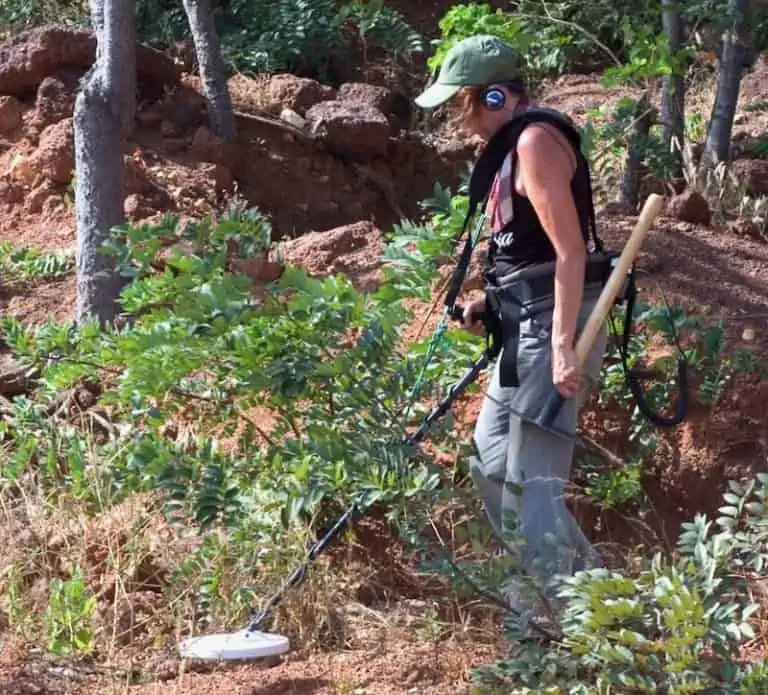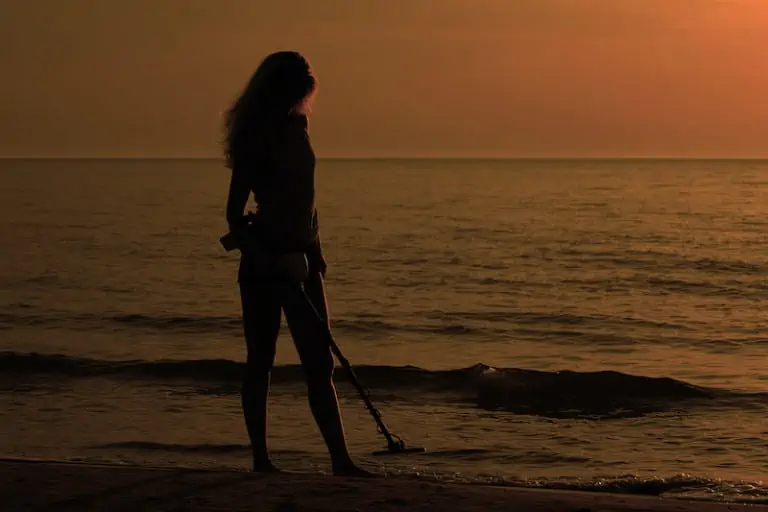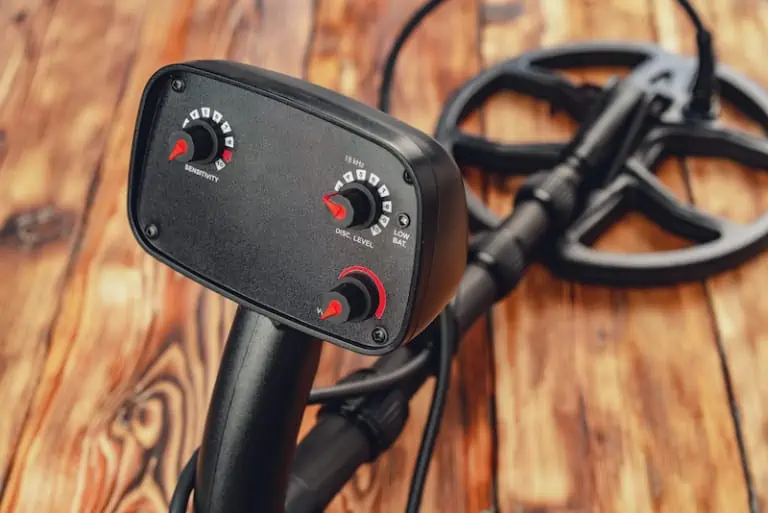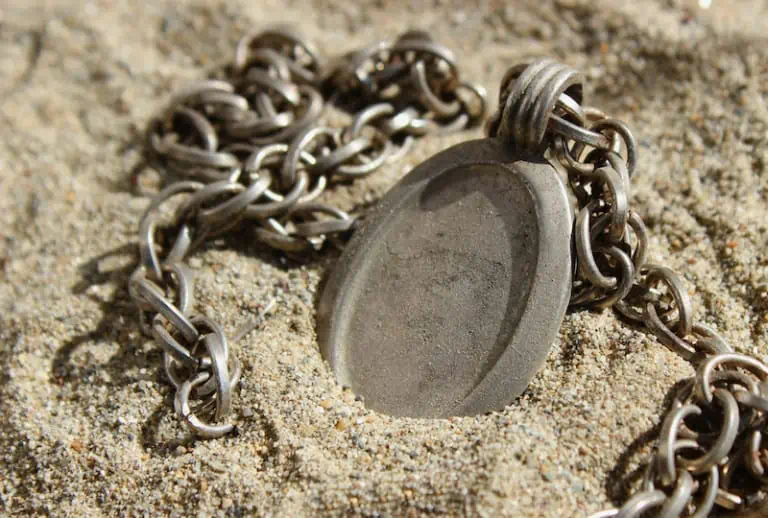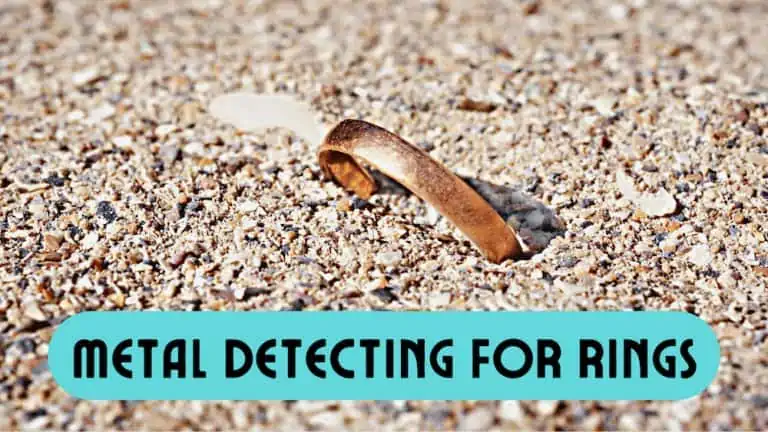49 Metal Detecting Tips for Underwater Detecting
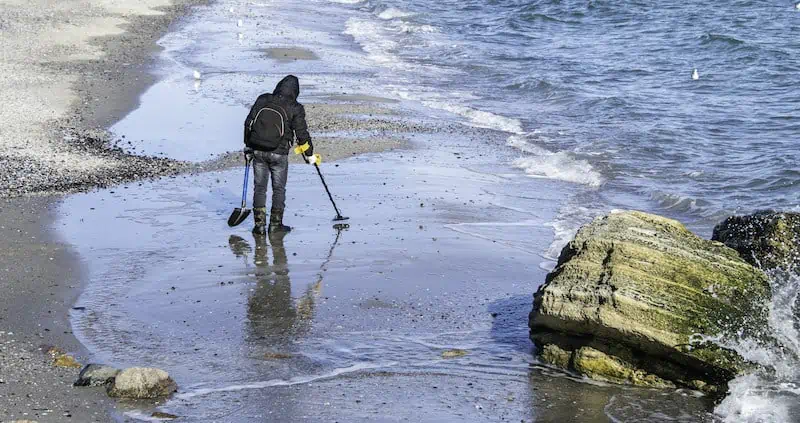
When planning an underwater metal detecting adventure, it is important to make sure you are properly prepared.
And that’s why, in this article, I’m going to provide you with fifty awesome metal detecting tips for underwater treasure hunting that should hopefully come in handy on your next hunt!
And before we begin, please take a moment to view the guide below that showcases a handful of the top affordable metal detectors available on the market:
| Photo | Model | Price | Features |
|---|---|---|---|
 | XP Deus Wireless | $$$ | 11” DD Coil |
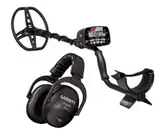 | Garrett AT Max | $$$ | Waterproof to 10 feet |
| Bounty Hunter TK4 Tracker IV | $ | 8” Waterproof Coil |
1) Plan Your Trip
To avoid wasting gas, money, and time, be sure to plan your trip fully before heading out. A well planned out trip will ensure you have chosen your location, packed the necessary gear, and fully understand the laws and regulations associated with metal detecting underwater.
Part of proper planning involves making sure you have the right detector by your side.
2) Choose the Right Time of Year
Metal detecting in water is most enjoyable during the summer months in many areas. If live closer to the equator where your weather is good all year round, you can detect enjoyably underwater any time! For those of us farther north, summer is the best time.
3) Choose the Right Metal Detector
Underwater metal detecting requires a fully submersible detector. It is important to know the depth you will be searching, as each detector is rated up to a certain depth. Some models are waterproof from 10 to 25 feet, while others are submersible up to 250 feet! Do some research into detector models and choose the one most appropriate for your target items and diving depth.
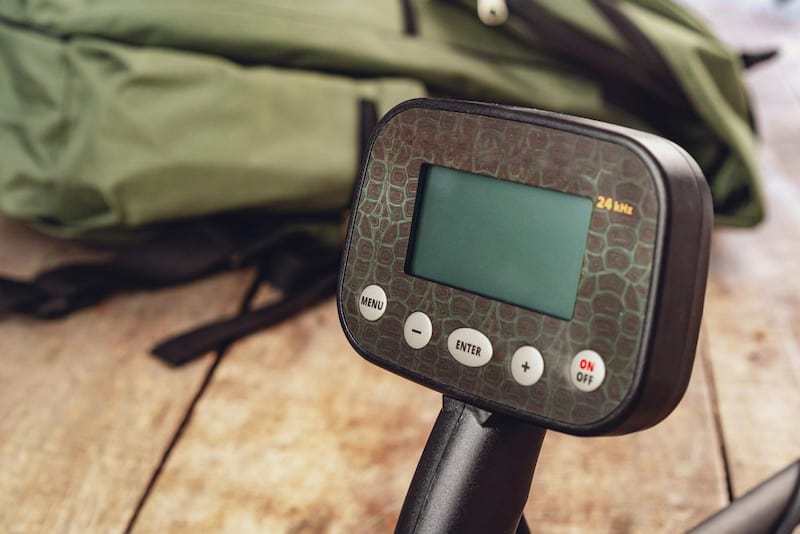
4) Saltwater Metal Detecting
When detecting in saltwater or sandy beach locations, the saltwater can throw off a traditional detector. In soils like these, the best bet is a pulse induction (PI) metal detector. These detectors work well in dry land, fresh water, or saltwater, but are best suited to saltwater areas. These detectors get better depth in saltwater than traditional very low frequency (VLF) detectors.
The Garrett Sea Hunter Mark II and the Tesoro Sand Shark are two of the best saltwater metal detectors that won’t break the bank. Both are PI machines that are submersible up to 200 feet and work well in sandy saltwater environments.
5) Freshwater Metal Detecting
If you are planning to metal detect in a lake or river, odds are it is a freshwater environment. For these locations, a VLF, or induction balance, detector is best.
It is important to make sure your VLF detector is fully submersible, not just the search coil. Most models offer a waterproof coil, but the control box is not waterproof. VLF detectors are traditionally less expensive than pulse induction models and are often lighter weight.
The Garrett AT Pro and Nokta Simplex are two of my favorite VLF detectors. These detectors are submersible up to 10 feet and have great features for both beginner and more advanced detectorists.
6) Choose Your Depth
It is important to determine whether you are more comfortable diving/detecting in shallower waters or deeper waters. Each detecting depth comes with its own set of challenges, and its own set of rewards! Shallow water, like rivers, lakes, reservoirs, swimming holes, etc., can be the resting place of lost loot from those recreating in the area.
These sites are known for jewelry, coins, electronics, and other common items. Deeper waters, such as some lakes and oceans, may harbor shipwrecked loot, ancient artifacts, and coins.
7) Choose Your Ideal Location
Choosing a location is one of the most important aspects of planning a treasure hunt. Locations, such as swimming holes, lakes, rivers, and other vacation sports will typically have plenty of lost loot for you to discover. The more people passing through an area means the more likely loot for you to find.
If you are detecting in deeper water, you have a greater chance of finding sunken artifacts, shipwrecks, or coin stores. These areas will require more training and more knowledge to access, and you should be well prepared before attempting to hunt these locations.

8) Shallow Water Detecting
You don’t have to dive deep to find treasure! Shallower waters can be found near popular recreation sites. These sites, due to the number of people, will be full of lost loot. If you are interested in shallower water detecting, familiarize yourself with snorkel gear, including proper goggles, breathing apparatuses, and flippers.
Shallow diving/detecting can be a good starting point for those wishing to detect via deep water diving in the future. This will help you become familiar with your detector’s functionality underwater and give you a peek into what to expect when training for deeper dives.
9) Freshwater Beach Detecting
There is plenty of fun to be had metal detecting on the beach! Beaches are popular places for recreating, and as such, can be the resting place of lost jewelry, electronics, coins, etc. Beach detecting requires a detector with a waterproof coil. Just be sure you do not fully submerge your detector if it only has a waterproof coil.
The Fisher F22 and Garrett ACE 400 are my two favorite beach hunting detectors. Both detectors work well on freshwater beaches but may prove difficult in saltwater conditions.
10) Creek, River, and Lake Detecting
If you are planning a hunt in shallower bodies of freshwater, it is best to have a fully submersible metal detector. While a waterproof coil detector will work if you are very careful, it is safest to have a fully submersible model. The recommended detectors for this type of hunting are the same as in the Freshwater Beach Detecting section.

11) Saltwater Beach Detecting
As mentioned in number 3, saltwater poses challenges to standard VLF detectors. Saltwater is highly conductive and can cause the detector to emit false readings. To combat this, a pulse induction (PI) metal detector is recommended for saltwater beach hunting. See number 3 also for my recommendations for the best PI detectors.
12) Practice Detecting on Dry Land
For any underwater detecting, but especially shallow water detecting, visibility may not be ideal. If you are detecting on the beach, odds are the lovely waves lapping the shore are causing a muddy mess underneath the surface. You should be very familiar with the sounds and sights of your detector as you must give more attention to digging techniques in the water.
13) Deepwater Detecting
Metal detecting in deeper waters can be extremely rewarding. There is a great satisfaction and fascination with finding artifacts or treasure hidden away from the world under the sea.
Deepwater detecting requires more training than shallow water hunting and has a more complex set of safety rules that should be followed. Deepwater metal detecting is only advisable for those sufficiently trained.
14) Scuba Diving For Deepwater Detecting
Before detecting at great depths, it is important to be familiar with deep water diving. Deep water divers will want to consider becoming certified in scuba diving. There are courses available in most cities, and the training will make detecting underwater much more comfortable.
Diving equipment is complex, and a firm grasp of diving will allow you to remain safe. Because hunters will have to dive 3 miles or more offshore, diving alone is not recommended.
15) Become Familiar with Your Equipment
Even if you are scuba certified, it is important to know your own equipment. Familiarizing yourself with all your diving equipment is one of the most important tips for a safe and successful underwater hunt. As mentioned previously, diving equipment can be quite complex.
It is critical to your safety and success for you to be completely comfortable with any and all diving equipment you will be taking. Double check every piece of equipment to root out any problems with the gear. This could literally save your life, so take your time with this step!
16) Use the Right Wetsuit
For shallow water where the temperature is warmer, a warm water wetsuit will be just fine. For deeper dives where the water is much colder, you will want a good insulated full wetsuit.
Cold water will take body heat 25 times faster than cold air, so it is critical to ensure you have a good wetsuit for deep dives.
17) Choose the Proper Accessories
Make a checklist of all the gear you will need for your hunt. When diving to great depths, visibility decreases significantly. Most diving equipment will be fitted with a light source. It is a good idea to bring along a high-powered flashlight for extra visibility.
You will also want to bring a long-handled, stainless steel trowel, as these make digging in hard soils easier, and keeps your knuckles from scraping along jagged rocks. Bring along at least one sand scoop to make sorting out targets easier.
Many underwater hunters take along a screwdriver to pry any objects lodged in rocks. You will want a mesh bag or other container to hold all your loot!
Many underwater metal detectors are heavier than non-waterproof detectors, so consider a chest harness, which will take the weight from the arms, making detecting for long periods easier. You may want underwater headphones to ensure you do not miss any signals, or you can use a detector that vibrates upon detection.
- You might also want to read: 10 Metal Detecting Accessories Needed for Treasure Hunting
18) Consider an Underwater Pinpointer
When you’ve come across a target, just as on land, it may be easier to use a pinpointer to find the target as you dig. There are several great underwater pinpointers available. The Fisher F-Pulse, Nokta PulseDive, and Treasure Products Vibra are my recommendations. The Fisher F-Pulse is for shallow water and is submersible up to 6 feet.
The Nokta PulseDive has the greatest depth; submersible to 200 feet. Treasure Products Vibra pointers are submersible to 100 feet. So just like the detectors, choose a pinpointer that works well for your diving depth.
19) Don’t Let Your Gear Get Away From You!
When in the water, if the current is strong or you lose grip, you may find yourself without some of your gear. It is a good idea to make sure each piece of gear is not only easily accessible, but either tied off to your suit, or does not float.
If your trowel gets away from you and it is very lightweight, it could float away in the current. If it is heavier, it may float a short distance then fall to the ground.
20) Try on Your Gear
To get an idea of how your gear will feel when you’ve got it all on, take some time to try everything on just as you would if you were detecting underwater.
You won’t want to weigh yourself down too much and restrict your mobility, so make sure you don’t overdo on the accessories. You can even gear up and take a short swim in shallower water to get a good feel for the weight of and location of all your gear.
You may find that when underwater your trowel isn’t as accessible as you thought it would be. So, make sure you get this all sorted out before you find yourself fumbling around at a depth of 200 feet!
21) Don’t Forget the Batteries!
Whether your detector requires standard batteries (most use AAs or 9-volts) or has a rechargeable battery, always make sure your detector has plenty of juice before heading out to detect! Can you imagine diving down to 200 or 250 feet, flipping on your detector, only to realize the batteries are dead?
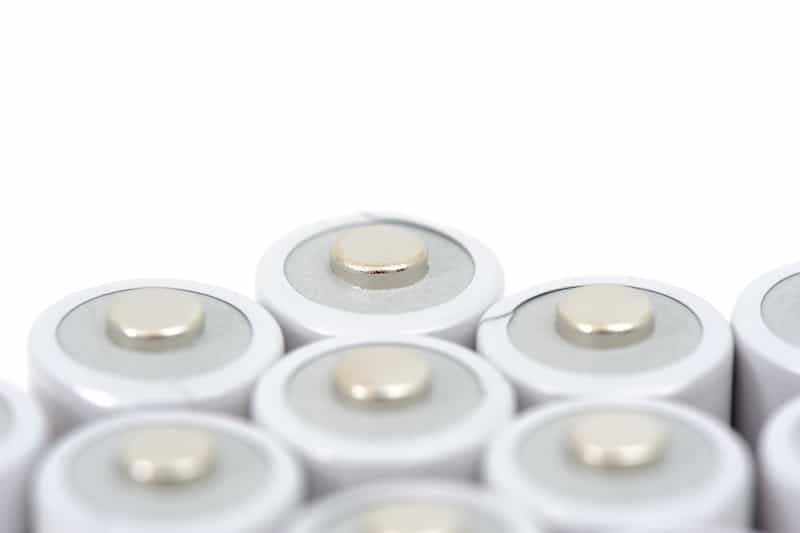
Along with detector batteries, check the battery power of each piece of electronic equipment you will be bringing. You’ll want fresh batteries in your flashlight, too, so you can see targets and your surroundings well.
22) Be on the Lookout for Wildlife
When detecting in any wild environment, it is important to have a general understanding of the types of wildlife common in the area. If you happen upon a cone shell, stonefish, or spiny urchin unprepared, you could be in real trouble. Cone shell and stonefish venom can cause respiratory failure. These animals are not generally aggressive, but it is still important to know what to look for.
Spiny urchins are not venomous but can deliver a painful jab. Corals can scratch or scrape your skin. It is also important to watch for sharks, if you are in area where they are common. Best to avoid contact with wildlife when possible, but if it is unavoidable, understanding the risks and procedures of dealing with wildlife can save your life.
23) Follow Safety Rules
There are many safety protocols when underwater metal detecting besides knowing your equipment, knowing how to dive, and watching for wildlife:
- Let someone know where you will be diving/hunting
- Always dive with a partner
- Always dive during daylight hours
- Use a surface marker buoy (SMB) or flag so boaters and divers know where you are
- Stay within visual range of other divers
- Keep headphones off unless actively metal detecting
24) Always Be Aware of Your Surroundings
It is always critically important to be aware of your surroundings. Changes in weather, changes in water current or temperature, visibility changes, or swimming into areas with high concentrations of wildlife are all things that should be carefully monitored. As stated before, it is always best to dive with a partner, and ensure you are using the proper safety equipment. Keep the other diver(s) within eyeshot and remain in contact with one another.
25) Know the Water Current
Understanding the water current where you will be detecting gives you several advantages. The current of the water will show you which direction the sand is moving, giving insight as to where metals might be stuck. Going along with the current will keep you from getting overtired trying fight against the current.

26) Use the Proper Settings
Always adjust your detector settings for underwater hunting. It is important to make sure your detector is adjusted for the depth and the type of targets you are looking for. Be familiar with the settings on your detector so you know what each tone and number (if it has an LCD screen) means.
27) Keep an Eye on the Weather
Mother nature is in charge on land or in the water. Metal detecting success is highly dependent upon the weather, so be sure to look ahead at the weather and visually keep an eye on the skies or have someone above water keeping track of any potential storms.
28) Watch the Tides
If you are just starting out, or wishing to detect on the beach, wait for low tide. This gives you access to deeper areas usually covered with water.
29) Consider Viewing Seafloor Maps
There are many maps of the seafloor, both physical and online. If you are deep water diving, you may want to consult these first, so you can get a relative idea of what the conditions in your chosen dive spot are like. There is an online map with twice the resolution of any previous seafloor map and shows many seafloor features.
30) Know Admiralty Laws
There are several laws surrounding detection and salvage of artifacts underwater. Laws will vary from country to country, and state to state. In the United States, all coastal waters within 3 miles of shore are considered property of the U.S. government. As such, detectors must hunt 3 miles or more offshore. Coastal states will have their own laws surrounding underwater salvage and antiquity protection. We will discuss some of these laws in detail.
31) Know the Law of Salvage
The Law of Salvage was designed to encourage those on the sea to help each other. If you see a vessel in trouble, you may be entitled to a reward for helping the troubled vessel.
If you discover such a vessel, you become the salvor, and must surrender the vessel and contents to the owner so long as the owner compensates the salvor for their actions. The amount of the reward is determined by:
The amount of risk undertaken by the salvor
The difficulty of the rescue/recovery
The value of the goods or vessel recovered
Salvage rewards are typically between 10 and 25 percent of the property value recovered by the salvor. The United States Marshall will place a maritime lien against the owner if he/she fails to compensate the salvor.
32) What to do if You Find a Shipwreck
Shipwreck diving/detecting can be one of the most dangerous types of underwater searching. Before detecting or removing anything from a shipwreck, it is imperative to find out whether the vessel’s owner has been actively searching for the ship, or in the process of reclaiming the ship. Shipwrecks can also be deemed Historic Places in the National Registry of Historic Places, in which case artifact removal is forbidden.
33) Where Can I Find Shipwrecks?
There are shipwrecks throughout the entire world. Some of the most notable can be found in Bermuda, the Cayman Islands, Curacao, Indonesia, and Australia. In the United States, Florida is the best place for shipwreck diving. Florida is known as “the dive capital of the world” by sports divers and underwater detectorists.
34) Know the Law of Finds
If a shipwreck has been submerged for a certain period during which the owners have not actively sought to retrieve the vessel or its contents, the discoverer is entitled to the full value of all goods recovered.

So long as the original owner of the vessel is not actively seeking the vessel and its contents, and no other exceptions apply (discussed below), the discoverer retains all legal rights.
35) Know Shipwreck Laws
Shipwreck sites have their own set of laws. The Abandoned Shipwreck Act of 1987 gives the U.S. government ownership of all shipwrecks within 3 miles of shore. The Sunken Military Craft Act of 2004 made all military shipwrecks property of the government, also. Fines for disturbing these vessels can be up to $100,000 per violation.
A shipwreck site may also be designated a marine sanctuary under the National Marine Sanctuary Act of 1972. The National Park Submerged Resources Center and Submerged Cultural Resources Unit maintain wrecks within National Parks that are labeled as culturally significant. The USS Arizona at Pearl Harbor, Hawaii and downed B-29 bomber plane in Lake Mead, Nevada are two examples of such sites.
36) Know River Hunting Laws
As with land metal detecting, each state will have its own laws regarding river hunting. For example, in my home state of Utah, there are rules for detecting in National Forest lands. You can detect, but no sluicing is allowed. If you do not follow the laws for metal detecting in your state, you may find yourself in hot water; possibly facing a misdemeanor or felony charge!
Ignorance is no defense, so always check your local laws before you venture out metal detecting on any state or federal lands. You can always put in a call or visit your local ranger station or city hall and they should be able to get the information you need. Better safe than sorry!
37) Know Beach Hunting Laws
Most beaches allow metal detecting. It is difficult to tell someone they can’t dig in the sand when that is one of the most popular things to do at beaches! Again, be sure to check with your local city hall or ranger station (if the beach is on state or federal property) to make sure you are following all the laws.
38) Know Private Property Laws
If you are detecting in a river or creek and it runs through private property, what do you do? The public owns the water, but the land is owned by someone else. Each state will have its own laws regarding detecting on private property and may require permission of the landowners.
Be sure to check your local state legislation if you plan to hunt in a river or creek passing through someone’s property.
39) Consider Joining a Metal Detecting Club
To make sure you have all the information you need for underwater detecting, consider joining a metal detecting club. There are many metal detecting clubs all over the country, and they are full of veteran and new detectorists who can help with any questions you may have.
- You also might enjoy: Are Metal Detecting Clubs Worth Joining?
40) Finding a Target
The best way to find an underwater target is to imagine a line across the seabed/lakebed. You can also set up your own line using rope and anchors. This will help you stay on track while underwater. Swipe the detector back and forth with 5 to 6-foot swipes on either side of the line.
Be sure to watch the seabed/lakebed carefully for the direction of the current, holes, pockets, valleys, and low spots where items could have become lodged.
41) Be Methodical in Your Search
Be sure to follow the tips for finding a target and be methodical with them. It can be very disorienting if you stray from your imaginary or real line underwater, so be sure to stay on track and scan the area thoroughly.
42) What Targets Can I Expect to Find?
There are many treasures just waiting to be discovered underwater. In rivers and creeks, there is a high potential for gold or other ores, and a whole lot of manmade items. In deeper water, there could be shipwrecks with cargo, lost pirate loot, or piles of coins.
In fact, there are more lost coins and jewelry in the ground and water than there are in circulation! How exciting would it be to dive down with your new underwater detector and find a pile of pirate coins or ancient Roman or Greek relics? The possibilities are endless!
43) You Found a Target in Deep water!
Once a target is located using the detector, there are a few ways to retrieve the item, depending upon the soil conditions. If the seabed or lakebed is hard or rocky, the long-handled trowel is your best bet. This tool is great for digging into difficult soils.
If your target is in 5 inches of sand or less, you can simply wave your hand just above the sand to move it along its way. After the current takes away the sand, you will have access to your find.
44) You Found a Target in Shallow Water!
If you are beach or shallow water detecting, a sand scoop is going to be your best friend upon finding a target. The sand scoop will remove larger quantities of soil, making finding the target easier. Because a sand scoop is either mesh or has holes, it can be used to sift out the sand, leaving behind the target.
Be sure if your sand scoop has holes that they are large enough to let the sand flow out, but not so large that small targets will get away from you. It is advisable, as on land, to dig a scoop of soil, move it somewhere dry, and detect it. This way, if a small target is stuck in the sand, it will not wash away back into the water.
45) Keeping Your Loot Safe
After you have found a target, depending on your depth, you will want to make sure to place the item in your mesh pouch or other carrying container. If you are in deep water or rushing river water, it is important to keep a good grip on your finds and tools.
It is best to quickly assess the target you have found so you can determine if you should stay in the same location or move on. After your quick visual assessment, stow the item in your bag so it doesn’t get away from you.
46) Assessing Your Finds
After you have completed your water hunt, it is time to really look over your finds! Carefully wash all the items off in a safe location. I recommend a tub (like a plastic tote) of clean water for the initial cleaning.
After you have removed the initial debris, you can determine based up each metal type, the best way to really clean them up.
47) Having Found Metals Professional Assayed
If you have cleaned up your finds and done some basic at-home testing to determine what you’ve got, you can always have your finds professionally assayed. There are many places where metals can be professionally assayed, so don’t be afraid to seek help if you are stuck identifying your loot!
48) Returning Others’ Property
There is always a chance you will come across a target, especially in a beach or other popular recreational area, that has an identifiable owner. It could be an engraved or class ring from the beach, an iPhone from the river, or a camera with SD cards. While these are technically now your property, you may wish to reunite the original owner with their lost items.
Thanks to social media, this has never been easier! You can do a little research if you’ve found a class ring or an item with someone’s name on it and attempt to find the owner, or post to a lost and found site on social media. Be sure they have some type of proof of ownership, though, so you are not simply passing on your hard-found loot to someone undeserving!
One of my favorite YouTubers, Nugget Noggin, reunites many of the items he finds with the original owner, and it is lovely to see how happy they are to have their phones, cameras, or jewelry back! Again, this step is not 100% necessary, because “finders keepers!” It is simply a suggestion for anyone wishing to carry forward this way. Do not feel guilty if you keep everything you find!
49) Enjoy Yourself
Possibly the most important tip on this list is to have fun! I know this article may seem a bit overwhelming, and there are a LOT of laws surrounding underwater metal detecting, but don’t let that stop you!
Underwater detecting has a higher yield than land detecting, and you can expect to find greater amounts of treasure. Plus, it’s just plain fun! So, get out there, learn your laws, buy the right detector and gear, and search away!
- If you enjoyed this article, please “like” our Facebook page!
You Might Also Want to Read:
